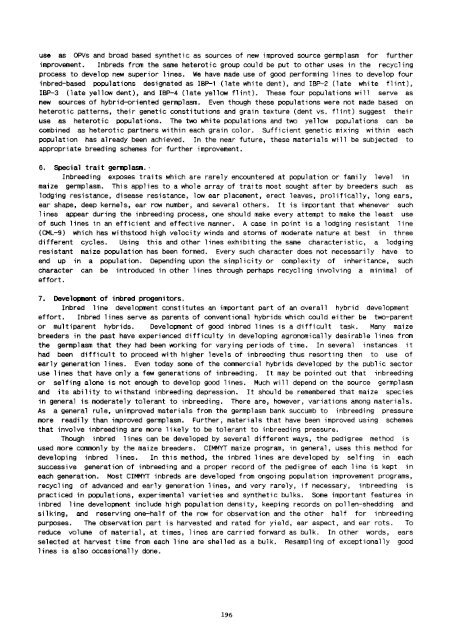Proceedings of the Fifth Asian Regional Maize Workshop - Search ...
Proceedings of the Fifth Asian Regional Maize Workshop - Search ...
Proceedings of the Fifth Asian Regional Maize Workshop - Search ...
You also want an ePaper? Increase the reach of your titles
YUMPU automatically turns print PDFs into web optimized ePapers that Google loves.
use as OPVs and broad based syn<strong>the</strong>tic as sources <strong>of</strong> new improved source germplasm for fur<strong>the</strong>r<br />
improvement. Inbreds from <strong>the</strong> same heterotic group could be put to o<strong>the</strong>r uses in <strong>the</strong> recycling<br />
process to develop new superior lines. We have made use <strong>of</strong> good performing lines to develop four<br />
inbred-based populations designated as IBP-1 (late white dent), and IBP-2 (late white flint),<br />
IBP-3 (late yellow dent), and IBP-4 (late yellow flint). These four populations will serve as<br />
new sources <strong>of</strong> hybrid-oriented germp1asm. Even though <strong>the</strong>se populations were not made based on<br />
heterotic patterns, <strong>the</strong>ir genetic constitutions and grain texture (dent vs. flint) suggest <strong>the</strong>ir<br />
use as heterotic populations. The two white populations and two yellow populations can be<br />
combined as heterotic partners within each grain color. Sufficient genetic mixing within each<br />
population has already been achieved. In <strong>the</strong> near future, <strong>the</strong>se materials will be subjected to<br />
appropriate breeding schemes for fur<strong>the</strong>r improvement.<br />
6. Special trait germplasm..<br />
Inbreeding exposes traits which are rarely encountered at population or family level in<br />
maize germplasm. This applies to a whole array <strong>of</strong> traits most sought after by breeders such as<br />
lodging resistance, disease resistance, low ear placement, erect leaves, prolifically, long ears,<br />
ear shape, deep kernels, ear row number, and several o<strong>the</strong>rs. It is important that whenever such<br />
lines appear during <strong>the</strong> inbreeding process, one should make every attempt to make <strong>the</strong> least use<br />
<strong>of</strong> such lines in an efficient and effective manner. A case in point is a lodging resistant line<br />
(CML-9) which has withstood high velocity winds and storms <strong>of</strong> moderate nature at best in three<br />
different cycles. Using this and o<strong>the</strong>r lines exhibiting <strong>the</strong> same characteristic, a lodging<br />
resistant maize population has been formed. Every such character does not necessarily have to<br />
end up in a population. Depending upon <strong>the</strong> simplicity or complexity <strong>of</strong> inheritance, such<br />
character can be introduced in o<strong>the</strong>r lines through perhaps recycling involving a minimal <strong>of</strong><br />
effort.<br />
7. Development <strong>of</strong> inbred pnogenitors.<br />
Inbred line development constitutes an important part <strong>of</strong> an overall hybrid development<br />
effort. Inbred lines serve as parents <strong>of</strong> conventional hybrids which could ei<strong>the</strong>r be two-parent<br />
or multiparent hybrids. Development <strong>of</strong> good inbred lines is a difficult task. Many maize<br />
breeders in <strong>the</strong> past have experienced difficulty in developing agronomically desirable lines from<br />
<strong>the</strong> germplasm that <strong>the</strong>y had been working for varying periods <strong>of</strong> time. In several instances it<br />
had been difficult to proceed with higher levels <strong>of</strong> inbreeding thus resorting <strong>the</strong>n to use <strong>of</strong><br />
early generation lines. Even today some <strong>of</strong> <strong>the</strong> commercial hybrids developed by <strong>the</strong> public sector<br />
use lines that have only a few generations <strong>of</strong> inbreeding. It may be pointed out that inbreeding<br />
or selfing alone is not enough to develop good lines. Much will depend on <strong>the</strong> source germp1asm<br />
and its ability to withstand inbreeding depression. It should be remembered that maize species<br />
in general is moderately tolerant to inbreeding. There are, however, variations among materials.<br />
As a general rule, unimproved materials from <strong>the</strong> germplasm bank succumb to inbreeding pressure<br />
more readily than improved germplasm. Fur<strong>the</strong>r, materials that have been improved using schemes<br />
that involve inbreeding are more likely to be tolerant to inbreeding pressure.<br />
Though inbred lines can be developed by several different ways, <strong>the</strong> pedigree method is<br />
used more commonly by <strong>the</strong> maize breeders. CIMMYT maize program, in general, uses this method for<br />
developing inbred lines. In this method, <strong>the</strong> inbred lines are developed by selfing in each<br />
successive generation <strong>of</strong> inbreeding and a proper record <strong>of</strong> <strong>the</strong> pedigree <strong>of</strong> each line is kept in<br />
each generation. Most CIMMYT inbreds are developed from ongoing population improvement programs,<br />
recycling <strong>of</strong> advanced and early generation lines, and very rarely, if necessary, inbreeding is<br />
practiced in populations, experimental varieties and syn<strong>the</strong>tic bulks. Some important features in<br />
inbred line development include high population density, keeping records on pollen-shedding and<br />
si1king, and reserving one-half <strong>of</strong> <strong>the</strong> row for observation and <strong>the</strong> o<strong>the</strong>r half for inbreeding<br />
purposes. The observation part is harvested and rated for yield, ear aspect, and ear rots. To<br />
reduce volume <strong>of</strong> material, at times, lines are carried forward as bulk. In o<strong>the</strong>r words, ears<br />
selected at harvest time from each line are shelled as a bulk. Resamp1ing <strong>of</strong> exceptionally good<br />
lines is also occasionally done.<br />
196

















